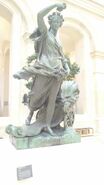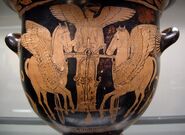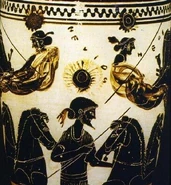Eos is the goddess of dawn in Greek mythology. Every morning, she rose from her home, at the edge of the River Oceanus, to deliver light and end night. She is associated with Aphrodite, and in Greek tradition Aphrodite cursed Eos to have a romantic longing for mortals.
Eos is often shown as the daughter of the Titans, Hyperion and Theia. Sometimes, she is known as a daughter of Pallas. She has two siblings; Helios, god of the sun, and Selene, goddess of the moon. Everyday she drives her chariot, pulled by two horses Firebright and Daybreak, to announce the day.
Depiction[]
Eos is often described having "rosy fingers" while opening The Gates of Dawn. Her dress is the colour saffron. She is pictured as a beautiful woman wearing a crown and having wings. Her aura is said to be "delicate".
In Greek mythology[]
Eos also plays a role in the epics of Homer. The Greek poet frequently mentions this beautiful goddess in the Iliad and the Odyssey, referring to her as "rosy-fingered", "early-rising", and "saffron-robed". The team of horses that pull her chariot across the sky are named in the Odyssey as Lampos and Phaethon (translated as Firebright and Daybright).
Goddess of dawn[]
At the beginning of each morning, Eos opens a set of gates to allow her brother Helios to pass into the sky. Some Homeric versions say that she also accompanies Helios as he completes his daily duties, in her own chariot pulled by the horses Firebright and Daybreak.
Lovers[]
There are a number of mythical stories about the affairs of Eos. Some scholars have attributed her strange fascination with mortal men to an unfortunate incident - apparently, the goddess of the Dawn had a fling with Ares. Aphrodite, the goddess of love and beauty, was no doubt angry that her lover had been involved with Eos, so she punished the dawn-goddess by making her fall for a series of mortals; Tithonus, Cephalus, and Orion are some of the fatal attractions of Eos.
Eos and Tithonus[]
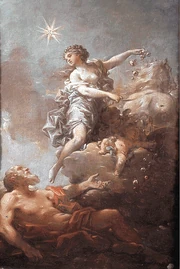
A painting of Eos and Tithonus
Eos fell in love with Tithonus of Troy and abducted him. She asked Zeus to turn him immortal, and Zeus agreed. However, she forgot to ask for Tithonus to be forever youthful. For some time, they were a happy couple and they always slept together. Slowly, Tithonus' hair started to grow grey and his body began to shrivel. Still Eos fed him and gave him nectar. He soon was unable to move. Eos locked him into a chamber, where he slowly withered away. Feeling sorry for Tithonus, the goddess turned him into a cicada. She has a child with Tithonus, Memnon.
Eos and Cephalus[]
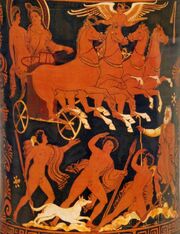
The rape of Cephalus by Eos.
Cephalus was a normal local boy, married to a woman named Procris. When he was hunting, Eos abducted him. Even though he was married, Eos bore him three songs, including Phaethon and Hesperus. However, Cephalus kept telling Eos she wanted to go back to Procris. Eos let him go, but kept telling him to question Procris' loyalty, Cephalus asked Eos to disguise him and then asked Procris to be his lover. Procris declined, but eventually agreed when he offered money. Cephalus was angry at Procris' betrayal, and they left eachother. However, they came back together. Slowly Procris was questioning Cephalus' loyalty, as when he was hunting she heard him calling the breeze to refresh his body. In Ancient Greek, breeze is "aura", and Procris wondered if he was calling the goddess of breezes, Aura. Procris followed Cephalus on his next hunting trip and, thinking she was an animal, threw his spear and killed him. Cephalus rushed to Procris, and Procris asked Cephalus to never marry Eos, and then she died.
Children[]
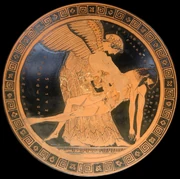
Eos mourns the death of her son, Memnon
Children often came from these romantic liaisons. Eos was the mother of several notable offspring, including the Winds (Zephyrus, Boreas, Eurus and Notus) and the Planets (Eosphoros, Phainon, Stilbon and Pyroeis) all of whom she bore to the Titan Astraeus; and Memnon, her son by Tithonus.
Gallery[]
Notes[]
References[]
[]
| Titans | |
|---|---|
| Parents | Ouranós • Gaîa |
| Elder Titans | Coeus • Crius • Cronus • Hyperion • Iapetus • Oceanus |
| Elder Titanesses | Dione • Mnemosyne • Phoebe • Theia • Rhea • Themis • Tethys |
| Coeonides | Asteria • Leto |
| Crionides | Astraeus • Pallas • Perses |
| Hyperionides | Eos • Hḗlios • Selene |
| Iapetonides | Atlas • Epimetheus • Menoetius • Prometheus |
| Oceanides | Potamoi • Rhode • Styx |
| Others | Anemoi • Astra Planeta • Kratos • Eurynome • Hecate • Lelantos • Melisseus • Metis • Nike • Ophion |
| Topics | Overthrowing of Ouranós • Titanomachy |


